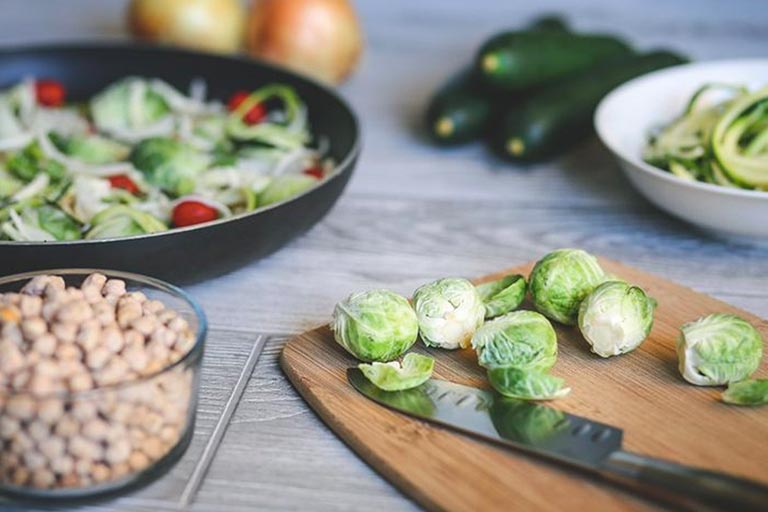If you’ve pushed off meal planning and prepping in the past, we’re here to change your mind! Meal prepping is the perfect method for reducing trips to the grocery store and avoiding food waste. Doing so will save you time and money in the long run, as well as reduce stress and unhealthy food choices by having healthy meals at the ready.
We are going to break down meal planning and prepping into simple and actionable strategies you can try to help you find the method and rhythm that works best for you and your family.
Before You Get Started
Here are a few quick tips to help you from feeling overwhelmed about the idea of meal planning and prepping:
- Choose recipes that you know you and your family will love: avoid prepping food that will be rejected and start with recipes that will be enjoyed and won’t go to waste.
- Start small: get comfortable with 2-4 recipes, start rotating those, and slowly start introducing new meals into your rotation.
- Think simple: stick to the basics and try prepping a few days or a week’s worth of protein, grains and veggies. Before you know it, you will be comfortable creating more detailed meals. Or, keep it simple. After all, simple is best.
- Fuss-free: for example, a spread of appetizers, breakfasts for dinners, and leftovers can each be put together to make nutritious and satisfying meals.
- Not entirely made from scratch: you can start with foods that are ready to eat and add healthy ingredients to make them more nutritious and filling. For instance, grab low-sodium canned soup, add frozen veggies, some herbs and spices, extra protein like shredded rotisserie chicken, and a teaspoon of olive oil.
- Prep the rainbow: include as many colors in your recipes to make sure you have a variety of nutrients.
- Aim for balance: when creating your meals, keep in mind the “magic plate,” a dish made up of vegetables, quality proteins, healthy fats, and smart carbohydrates.
- Have a few emergency meals on hand: best for those unexpected evenings, it’s a good idea to have emergency meals in your freezer, fridge or pantry. Examples include cauliflower pizza or bean burritos from your freezer, avocado toast or hummus and veggies from your fridge, or protein-packed pastas (such as the ones made from lentils or chickpeas) topped with pasta sauce from your pantry. Once you have meal planning down, include a meal you can freeze ahead, so that you can accumulate several to have on hand for emergency dinners.
- Keep a spreadsheet of your recipes and meal plans: this will help you stay organized and ensure you always have ideas at the ready and will keep you from having to reinvent the meal wheel. You can save links to recipes you have tried and liked, as well as ones you want to prepare in the future.
- Do the best that you can: the intent of this practice is to help simplify and improve your life. Just do your best and, as much as possible, have fun in the kitchen!
Taking Inventory
Take the time to take inventory of what you have in your fridge, freezer and pantry. Create a checklist or print a free one from the many options online. Taking inventory might take a couple of hours, so make sure you eat before doing this or you might end up raiding the fridge and pantry. Think about what you can use from your inventory and start writing down where you need to fill in the gaps.
Not only will taking inventory help you discover what you already have in stock and what you need to purchase but it will also provide you with the opportunity to clean, organize which will save you time and money in the long run. This practice can also play a role in reducing stress via the act of cleaning and creating decongested spaces.
Meal Planning and Prepping
Writing down all the things that are coming up for the week is a great visual for figuring out how to plan ahead. This is also a way to work through any potential barriers. Your week may look different depending on what’s happening in your home at any given time. With that in mind, write down how your upcoming week is looking and start coming up with some easy, healthy meals that you have used in the past or would like to try.
It can help to break down meal planning and prepping into two separate tasks to make things less overwhelming. Writing out the plan, creating your list and shopping can be done on one day and preparing the meals can be done the next. Alternately, you can also prep and cook meals twice in a week. For example, on a Sunday and Wednesday. You will find what works best for you based on you and your family’s scheduled needs through trial and error.
Here are some ideas on how you can create meal plans:
- Create a schedule of meal plans based on themes—for example, meatless Mondays, pasta on Tuesdays, sandwiches on Wednesdays, salads on Thursdays, fish on Fridays, quiche on Saturdays, slow-cooker meals on Sundays.
- Each house member can choose a meal or two they want to have that week—if you live with others, get them involved! This is also a wonderful way to get kiddos in the kitchen, and excited about trying new foods, as well as utilizing skills that they learn in school (math, science, home economics, history, etc).
- Meal plan according to what you have at home—go “shop” in your fridge, freezer, and pantry to see what you can make for the week out of what you already have.
- Meal plan according to seasons—salads and cooler foods are great for warmer seasons, while warm foods are perfect for the colder months.
- Meal plan according to a new or favorite cookbook—this is great way to finally break into that cookbook you have been itching to try, or into some old favorites
Different Types of Meal Prep
- Make-ahead meals—full meals cooked in advance which can be refrigerated and reheated at mealtimes.
- Batch cooking—making large batches of a specific recipe, then splitting it into individual portions to be frozen and eaten over the next few weeks or months. These make for popular warm lunch or dinner options.
- Individually portioned meals—preparing fresh meals and portioning them into individual grab-and-go portions to be refrigerated and eaten over the next few days. This is particularly handy for quick lunches. Also works for breakfast items like healthy muffins or homemade protein bars.
- Ready-to-cook ingredients—prepping the ingredients required for specific meals ahead of time as a way to cut down on cooking time in the kitchen.
- Choose or create your own method—The different meal-prepping methods can also be mixed and matched depending on your own circumstances. Start by choosing the most appealing method, then slowly experiment with the others to determine what suits you best.
Grocery Shopping
Here are food items that may prove to be the most logical and healthiest to buy while meal prepping:
- Frozen produce: vegetables and fruit. Try to get organic when possible. These are often as healthy or healthier than their raw counterparts, because they have been frozen immediately after being picked.
- Frozen protein options: chicken, beef, fish, organic edamame.
- Eggs
- Bread products, regular or gluten-free: you can freeze if you need to keep longer.
- Heartier vegetables: regular and sweet potatoes, onions, beets.
- Fruits: apples, oranges, grapefruits and bananas also have a longer shelf life.
- Whole grains and pseudograins: rice, pasta, quinoa, buckwheat, etc.
- Canned beans and legumes: such as kidney beans, black beans, chickpeas and lentils to add to your salads and soups or to make bean dips like hummus or a hearty vegetarian chili from scratch.
- Canned tomatoes: to be used in soups/stews
- Canned fish: tuna, salmon, sardines (can make salads or patties out of them)
- Nut/seed/legume butters: almond, macadamia, peanut (go for organic and without added oils/sweeteners), sunflower seeds.
- Condiments: mayo, mustard, ketchup.
- Herbs and spices: adds a lot of flavor.
- Healthy oils: olive, avocado, coconut oils. Can be used for cooking or dressing.
- Baking goods: regular or gluten-free flours if you plan to do some baking, sweeteners like sugar, honey, and stevia, baking powder.
- Dark chocolate: 70% or higher, can be used for baking, or if you need to satisfy a sweet tooth
Simplifying Meal Prep
- Get essentials ready—ingredients, cookware, kitchen towels.
- Pre-prep as much as possible—cleaning produce, chopping, boiling water, heating oven, etc.
- Get house members involved—if you live with someone else, designate ways they can help. A fun way to connect and interact, as well as an opportunity for kids/teens to practice essential life skills.
- Clean as you go—this will keep your area clean and organized and will save you time at the end.
- Keep a bowl for scraps—instead of having to go back and forth to the trash, you can keep it all in one place until the end.
- Keep things simple—oftentimes, the simplest meal preparations are the best: simple protein prep (ground beef, grilled fish, stir fried chicken), healthy vegetables (grilled, roasted, steamed), simply made smart carbs (baked sweet potato, lentils, quinoa).
- Store appropriately—in fridge and freezer, preferably in glass containers or otherwise BPA-free containers.
- Think how you can mix and match—vegetables, protein, smart carbs, healthy fats (avocados, olives and their oils, nuts/seeds)
One of the best parts of meal prepping is that you have leftovers that you can freeze, eat the next day, or use to repurpose into other meals. Think of it this way: today’s leftovers can transform into tomorrow’s soups, stews, omelets, pastas, salads or smoothies.
Now that you have reviewed some meal planning and prepping basics, here are some simple and healthy recipes that use a short list of ingredients, and that anyone—even a young child or a beginner cook—can easily make:
- Healthified sloppy joes—only ingredients are grass-fed ground beef, no sugar added pasta sauce, and raw honey. Cook beef all the way through, add sauce and honey. Mix well. Perfect on a bun or baked potato, or with a side of non-starchy vegetables for a low-carb option. Great for batch cooking and freezing.
- Egg muffins—mix eggs, spinach, bacon and cheese if you wish, and add salt and pepper. Bake for 20 minutes on 350 in a muffins pan lined with muffin cup liners. These make for perfect grab and go breakfasts, as well as healthy snacks.
- Shakshuka—a Middle Eastern favorite, which I prepare with onions, no sugar added pasta sauce, eggs, and spices. To add more substance, you could also add ground meat or black beans. Sauté the onions in a bit of avocado oil and add the pasta sauce, and when the skillet is hot, add the eggs. Put the heat on low and cover with a lid so that the eggs can fully cook. If adding cooked ground meat and/or beans, cook along with the sauce prior to adding the eggs.
- Quesadillas—place a tortilla of your choice (preferably organic) on a warm skillet, top half of it with organic or raw milk cheese and shredded or sliced cooked chicken. Fold tortilla in half (low heat temp) and turn when the bottom side is slightly browned. Serve with cut up vegetables and homemade guacamole.
- Simply baked salmon—so easy. Take fresh or frozen salmon, top with salt, pepper, dill, and lemon slices, and bake at 350 for 25 minutes. Serve alongside grilled, roasted, or steamed veggies and a baked sweet potato.
Keep in mind that there is no right or wrong way to meal prep! There is only the way that works best for you and your needs. Meal prepping is meant to enhance your life, so do what is necessary to make this as enjoyable and stress-free as possible!



